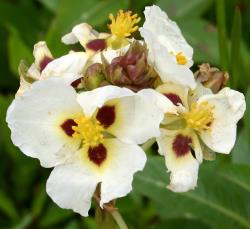Perennial (in New Zealand), mostly emergent, glabrous, aquatic herbs. Rhizomes, stolons and corms often present. Roots fibrous, septate. Monoecious, polygamomonoecious, dioecious (rarely). Leaves from a basal rosette, petiolate (emergent leaves) or non-petiolate (submergent leaves); leaf-bases lobed or non-lobed on emergent leaves. Inflorescence a whorled raceme or panicle, bracteate, staminate flowers above, carpellate below on the same scape. Flowers imperfect, usually functionally unisexual, staminate flowers only or with non-functional carpels, carpellate flowers only or with staminodes; pedicellate. Androecium 6–many stamens in whorls; filaments linear, subulate or dilated, glabrous to densely pubescent; anthers nearly basifixed, extrorse dehiscence. Gynoecium with many free carpels spirally attached to a conical receptacle, style terminal; ovule placentation basal. Fruit a flattened obovate achene, beaked, winged. Seeds uncinate, glandular, without hairs.
Sagittaria was monographed by Bogin (1955), and a regional revision was written by Haynes & Holm-Neilsen (1994) for the tropical Americas. Keener (2005) revised Sagittaria providing dichotomous keys, descriptions, and distribution maps for 40 species and eight infraspecific taxa.
| 1 | Leaf bases cuneate or leaves linear | 2 |
| 1' | Leaf bases lobed, either sagittate or hastate | 3 |
| 2 | Plants to 150 cm tall; inflorescence emergent, stout; filaments pubescent | platyphylla |
| 2' | Plants to 90 cm; inflorescence floating, lax; filaments glabrous | subulata |
| 3 | Petiole semi-terete; rhizome thick and upright, corms and stolons absent | montevidensis |
| 3' | Petiole trigonous; corms and stolons present | Sagittaria sp. [Sagittifolia Group] |
Sagittaria sp. in the key refers to the presence of an unidentified species in the Sagittifolia Group (Keener 2005), which has never been seen flowering – it is likely one of following species: S. latifolia, S. sagittifolia or S. trifolia. One field population has been found occurring in a small tributary of the Huruhurutakimo Stream, Whenuakite, Coromandel Peninsula, and it is likely the same species found in cultivation in several locations in New Zealand, presumably grown for the edible tubers. One of the species in the Sagittifolia Group, Sagittaria sagittifolia, is a designated unwanted organism in New Zealand under the Biosecurity Act. It is banned from sale and distribution and is targeted for eradication wherever it occurs.
Separate male and female flowers on the same plant (monoecious), septate roots, and showy, white, petaloid flowers will distinguish Sagittaria from Alisma and Hydrocleys.
About 30 to 35 species of both tropical and temperate regions, with many species occurring in the Americas; also in Eurasia, West Africa, China, Japan, South East Asia.
| Category | Number |
|---|---|
| Exotic: Fully Naturalised | 3 |
| Total | 3 |
2n = 11.
All four naturalised species of Sagittaria have been recorded for the first-time post Healy & Edgar (1980).




